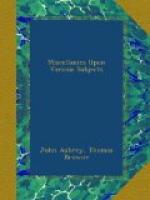Combe are. So likewise in his remembrance, was
all between Kington St. Michael and Dracot-Cerne common
fields. Then were a world of labouring people
maintained by the plough, as yet in Northamptonshire,
&c. There were no rates for the poor in my grandfather’s
days; but for Kington St. Michael (no small parish)
the church-ale at Whitsuntide did the business.
In every parish is (or was) a church-house, to which
belonged spits, crocks, &c., utensils for dressing
provision. Here the house-keepers met, and were
merry, and gave their charity. The young people
were there too, and had dancing, bowling, shooting
at butts, &c., the ancients sitting gravely by and
looking on. All things were civil and without
scandal. This church-ale is doubtless derived
from the {Greek text: agapai}, or love-feast,
mentioned in the New Testament. Mr. A. Wood assures
me, that there were no alms-houses, at least they
were very scarce before the Reformation; that over
against Christ Church, Oxon, is one of the ancientest.
In every church was a poor man’s box, but I never
remembered the use of it; nay, there was one at great
inns, as I remember it was before the wars. Before
the Reformation, at their vigils or revels, sat up
all night fasting and praying. The night before
the day of the dedication of the church, certain officers
were chosen for gathering the money for charitable
uses. Old John Wastfield, of Langley, was Peter-man
at St. Peter’s Chapel there; at which time is
one of the greatest revels in these parts, but the
chapel is converted into a dwelling-house. Such
joy and merriment was every holiday, which days were
kept with great solemnity and reverence. These
were the days when England was famous for the " grey
goose quills.” The clerk’s was in
the Easter holidays for his benefit, and the solace
of the neighbourhood.
Since the Reformation, and inclosures aforesaid, these
parts have swarmed with poor people. The parish
of Cain pays to the poor (1663) L500 per annum; and
the parish of Chippenham little less, as appears by
the poor’s books there. Inclosures are for
the private, not for the public, good. For a
shepherd and his dog, or a milk-maid, can manage meadow-land,
that upon arable, employed the hands of several scores
of labourers.
In those times (besides the jollities already mentioned)
they had their pilgrimages to Walsingham, Canterbury,
&c. to several shrines, as chiefly hereabouts, to
St. Joseph’s of Arimathea, at his chapel in
Glastonbury Abbey. In the roads thither were several
houses of entertainment, built purposely for them;
among others, was the house called “The Chapel
of Playster” near Box; and a great house called
....... without Lafford’s Gate, near Bristol.




